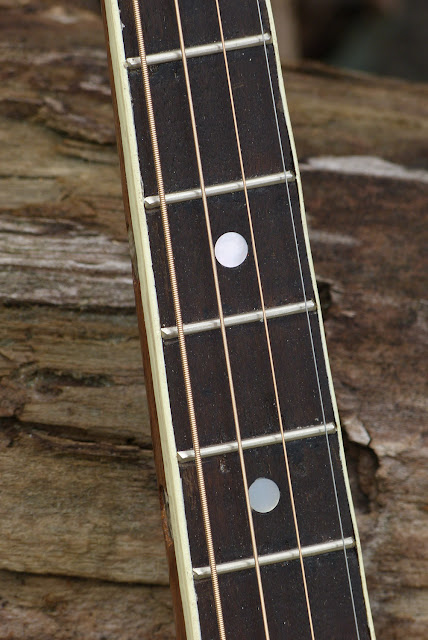1920s Harmony-made Size 5 Tenor Guitar
I'm pretty familiar with this type of tenor guitar, having worked on two similar ones (a mahogany-topped one and a spruce-topped one) and handled two more for light setups, but this one is the fanciest of the bunch, so far, with thicker (and more) binding and an upscale presence. They're short scale (this has a 21 1/4" scale) and have 12-fret joints so you get the most "reach" out of these in some variation of 5ths tuning (either standard CGDA or octave mando GDAE -- the latter of which the owner had it strung-up in). As 12-fretters they also sound pretty darn full and warm for their size with the bridge so low on the bout.
A customer of mine called me up about fixing this a while back and friends of his dropped it by to get it done. It looks like the hairline cracks were repaired and a replacement (but well-made and correctly-shaped) bridge was put on in the recent past, though the neck needed a reset and the owner wanted it refretted (the original frets were very shallow and the neck did have a bit of warp to it).
So -- the easy part of the job was knocking the neck back, filling some extra tuner holes in the headstock, and modifying the bridge a bit to accept a wider, compnesated saddle.
The hardest bit was the refret job and that's because this is a Harmony and most Harmony boxes from the time used an "ebonized" maple fretboard that gets truly mealy and spongy over time. To refret it I needed to reglue portions of the board that were loose, pull the old frets (which, as usual, made some crazy chipping on the board because of the material), patch chip-outs, level and polish the board, and then gingerly refret it so as not to squeeze too hard on the board (which, due to the compromised material, tends to compress like mad). The frets are also wicked with super glue and a bit of sanding dust from the board to keep them in place. Compared to a normal refret job (pull the frets, lightly level and polish the board, and pop new ones in with a caul on my drill press), there's a lot of frustration involved on a board like this -- but thankfully I'm used to it from having to work on scores of these poor old things.
The end result, however, is a perfectly-playing, great-sounding, happy old tenor -- so I'm well rewarded for the trouble.
When I filled the old holes at the headstock, I also lightly-sanded and finished it in the same vein as the fretboard so that the job wasn't obvious. The veneer is stained maple like the board.
The board has pearl dots, new "medium" frets, and thicker-than-average (for the time) celluloid binding. The binding was brittle and cracked in a couple places when I took it off to do the refret but I managed to fit it back together decently. When the instrument came in the binding was also "swelled-out" from the wood, so when I reglued it to the board I scraped it down flush with the neck for a much better feel.
I love the look of the trim -- the 4-ply purfling behind tortoise binding looks great.
The replacement bridge was made of rosewood and looks good -- though I did have to recut the saddle slot slightly forward and wider to get intonation a bit better. It's hard to make such a short scale intonate perfectly all over -- especially when one can visibly see that Harmony's fret-slotting was not... exactly... on-the-dot! -- but it's dialed-in as good as it gets, now.
The owner had this strung with some pretty hefty strings for GDAE tuning and I've backed them off a bit at 46w G, 30w D, 18w A, 12 E. The neck is probably fine with heavier gauges but the ladder-braced tops on these are built so lightly it's best not to test them too much.
I have the action set at hair-under 3/32" for the G and 1/16" for the rest at the 12th fret.
The original Grover geared banjo tuners are nice to have!
The best bit are the "customized" fret markers. How cool is that? And that hair!
















Comments